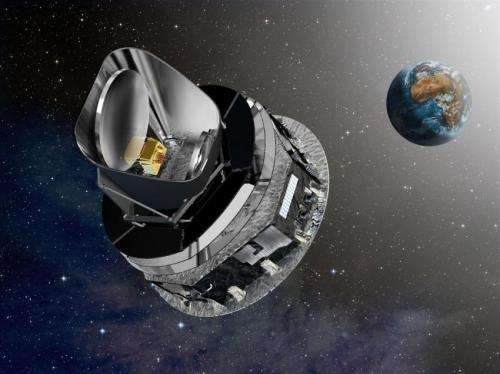With new data, Planck satellite brings early universe into focus

From its orbit 930,000 miles above Earth, the Planck space telescope spent more than four years detecting the oldest light in the universe, called the cosmic microwave background. This fossil from the Big Bang fills every square inch of the sky and offers a glimpse of what the universe looked like almost 14 billion years ago, when it was just 380,000 years old. Planck's observations of this relic radiation shed light on everything from the evolution of the universe to dark matter.
Just this month, Planck released new maps of the cosmic microwave background supporting the theory of cosmic inflation, which posits that the universe underwent a monumental expansion in the moments following the Big Bang. During this time, space expanded faster than the speed of light, growing from smaller than a proton to an enormity that defies comprehension.
Yet the theory of inflation is not yet a full and detailed theory that can completely explain the universe's earliest moments. "We don't yet understand the fundamental physics that drove inflation, and we certainly don't understand the details of how it worked," said George Efstathiou, director of the Kavli Institute for Cosmology at the University of Cambridge and one of the leaders of the Planck mission. Efstathiou offered his insights during a recent conversation with The Kavli Foundation. "What we need is better experimental data that tells us what the early universe looked like and hopefully this will point us toward a fundamental theory of inflation."
That said, the latest Planck data do support the general idea that the universe expanded mindbogglingly fast in its first moments. The data also offers insight into neutrinos, the tiny, ubiquitous particles known come in three types but whose mass is still unknown. Previous experiments determined the lightest these particles could be; the Planck results have now set a limit on heaviest they could possibly be.
"We're narrowing down the options, and will hopefully soon learn their exact mass," said Efstathiou. "Neutrinos are some of the most mysterious particles in the universe, so this would be an important step toward understanding them."
Planck also looked for dark matter - the mysterious substance that makes up 20 percent of the universe yet has yet to be well understood - but found no signal whatsoever. That's not all that surprising, said Efstathiou. Dark matter is easy to hide, and it will take future experiments to find it. Theorists have also suggested that dark matter might interact in some way with dark energy, the substance that permeates all of space and pushes the universe apart. From the Planck data, Efstathiou said, it looks like dark energy is completely constant and does not interact with dark matter.
In addition, Efstathiou said that although no experiment has yet detected gravitational waves, ripples in the curvature of space-time that, if they exist, could help prove the theory of inflation, future experiments have a good shot at it.
"If you look at the [data], you see that there's plenty of room for gravitational waves to be lurking there, just below the level" we can see, he said. "If that's true, it shouldn't take a very long time to dig it out. So there could be a very important development coming."
More information: www.kavlifoundation.org/scienc … early-universe-focus
Provided by The Kavli Foundation




















